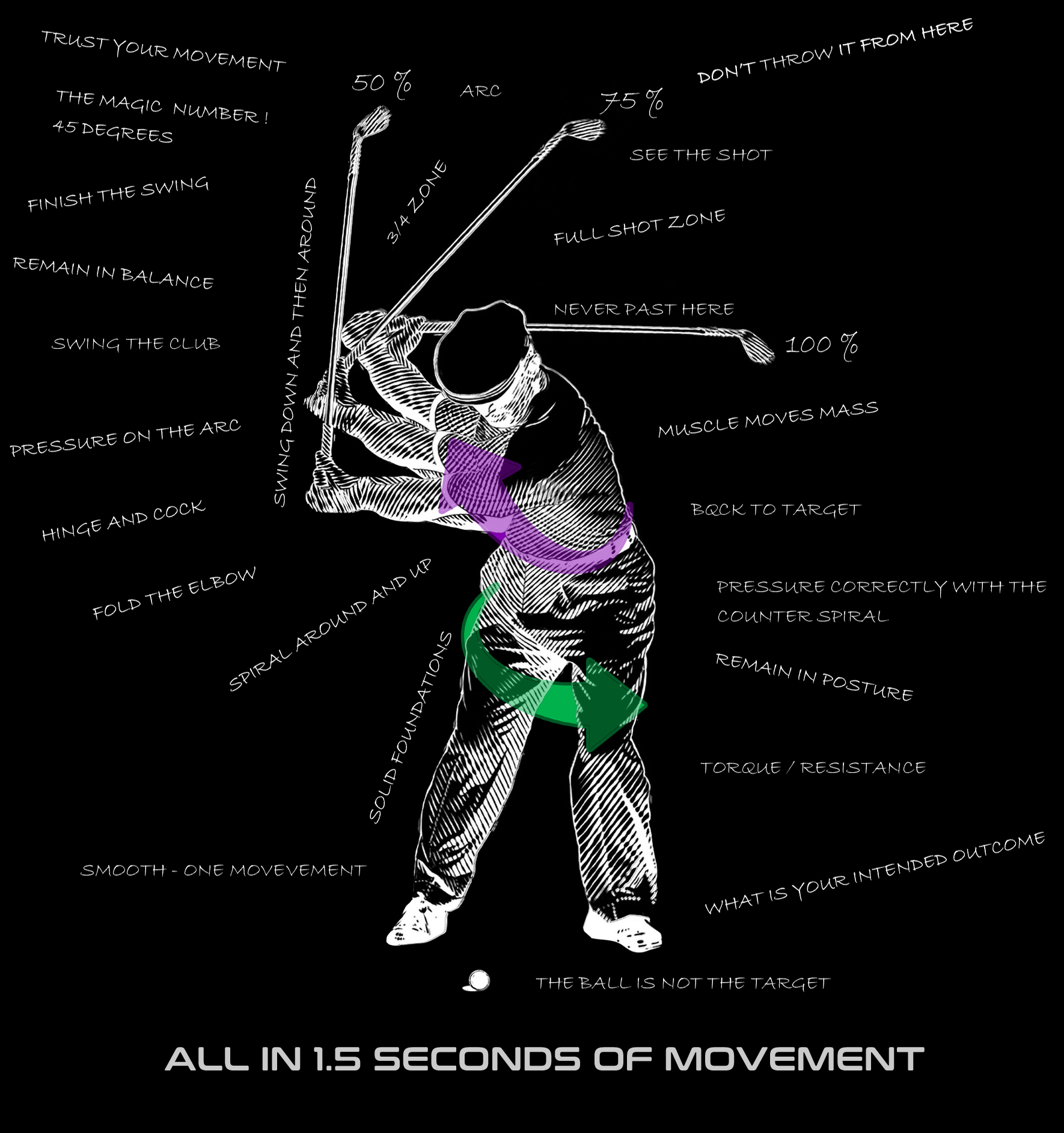CODE1 Tutorial
CODE 1 - GOLF IT ONLY A MOVEMENT
Part of the Accelerated Learning Peter Cowen Signature Exercises. The wide stance drill would be the number one exercise coach Pete recommends if there was only one drill you choose to perform daily. Read More below


Do you find you can strike the ball perfect some days and not others?
Are you better on the driving range and unable to produce the goods on the course?
Are you really thinking about all these details in just 1.5 seconds during your golf swing?
Does This Look Familiar?

There Is An Old Adage In Golf "The Secret Is Found In The Dirt" Ben Hogan. Although There Is Some Truth To A Golfer Having To Dig Up A Certain Amount Of The Practice Range, Pete Knows There Is A Better Way.
IF I HAD MY TIME AGAIN THIS IS WHAT I WOULD DIFFERENTLY.
Peter Cowen.The Evolution of Golf: Mastering the Stationary Ball Game
Since the 15th century, we've approached golf as if it were a moving ball game, picking up the club and hitting the ball with force and hope. This method works well for moving ball games, but golf is fundamentally different; it's a stationary ball game. The key to mastering golf lies in moving the club correctly, ensuring that the body, arms, hands, and club work in harmony so the ball simply gets in the way of this natural movement.
I have likely hit more golf balls than anyone, probably over four million, and yet have never seen the clubhead strike the ball because it happens so fast. This realization has led to a profound insight: one might as well be blindfolded, focusing solely on the movement because the ball will be there.
While improving one's strength can undoubtedly aid performance, it is not the be-all and end-all. The essence of golf lies in the cor-rect movement of the body, arms, and club. Even an 80-year-old can hit decent shots if they achieve the proper movement, proving that golf is a physical activity rooted in natural, injury-free motions.
The goal is for players to consistently repeat the same body action every time, complemented by the precise arm, hand, and club ac-tion that guides the club on an arc relative to the intended shot. With an iron, this arc should collect the ball before reaching the low point of the swing, compressing the ball before contacting the ground. This technique not only improves accuracy and power but also promotes a smoother, more efficient swing.
To truly progress in the game of golf, we must embrace a new way of thinking. It's not just about brute force or sheer strength; it's about precision, consistency, and the natural alignment of movements. By focusing on these aspects, we can unlock a faster path to improvement and a deeper understanding of the game.
In summary, the future of golf lies in mastering the stationary ball game through natural, harmonious movements. As we refine our techniques and embrace this approach, we can elevate our game to new heights, achieving both consistency and excellence on the course.
To master the movement, you must first practice it with deliberate intent. Improving your subconscious response requires conscious effort and attention initially. By focusing intently on each aspect of the movement, you lay the groundwork for instinctive, seamless performance over time.
On 15 minutes a day, you can definitely improve. Everybody can improve.
The problem is nobody will do it.
Peter Cowen.
With just 15 minutes a day, you can undoubtedly improve your golf game. The challenge is that few are willing to make this small, consistent effort. Ask yourself: do you dedicate 15 minutes a day to improving your quality of life? If not, it’s understandable why committing to practice can be difficult. But what if I told you that dedicating just 15 minutes daily could almost guarantee a signifi-cant improvement in your game? I can confidently say that with 99.9% certainty, this practice will make you a better golfer.
Let me explain why 15 minutes a day is so powerful. Consider a round of golf: a decent player hits around 40 full shots. Each golf swing takes approximately 1.5 seconds. So, 40 shots amount to just 60 seconds—only one minute of actual swing time. When I ask players how many of those shots were good, they typically say five or six. That’s only 10 seconds of productive practice versus 50 sec-onds of unproductive swings.
Now, let’s imagine you go to the range and hit 400 balls. In reality, you’d get tired before reaching that number, but for the sake of argument, let’s assume you did. That’s 400 swings at 1.5 seconds each, totalling 600 seconds, or 10 minutes. When asked about the quality, players often report a 50-50 split between good and bad shots. This mix confuses the brain, making it harder to internalize the correct movement patterns.
Instead of this ineffective practice, imagine dedicating just 15 minutes a day to perfecting the right movements. This focused practice would allow you to train your brain and muscles consistently and effectively. By concentrating on quality over quantity, you would see rapid improvement.
In summary, a round of golf gives you one minute of effective practice, and hitting 400 balls gives you 10 minutes, mostly unproduc-tive. But dedicating 15 minutes daily to perfecting your swing can bring about significant improvements. I’m going to show you spe-cific drills to train your brain, body, and muscle structure. With this approach, improvement is nearly guaranteed.
So, commit to those 15 minutes a day and watch your game transform.
The Art of Playing Better Golf with Less Thought
The key to improving your golf game lies in reducing the amount of thought during play. The Pyramid of Learning , a time-tested ap-proach, addresses the needs of all types of golfers. Whether you're a novice or an experienced player, this structured method can help you understand and master golf movements.
If you are a new golfer reading this then our recommendation is to build solid foundations and rely on less manipulations if possible. Our hand eye coordination allows for manipulation and all golfers including the worlds best have this. That is why there is not a one size fits all approach. The Accelerated Learning drills allow for experienced players to develop and improve feels from the top of the pyramid downward. Using the Accelerated Learning drills you would no doubt develop solid foundations.
Structured Learning for All Golfers
For new golfers- Build Solid Foundations: Focus on developing a consistent and reliable movement.
- Minimize Manipulations: Try to reduce the need for constant adjustments.
- Accelerated Learning Drills: Use these drills to quickly develop strong fundamentals.
For all golfers
- Understand the Movement: Work through the pyramid systematically to grasp the intricacies of golf.
- Consistency: Developing a repeatable movement pattern is crucial for long-term success.
Are you approaching golf practice the right way?
Take a look at the structured approach section to learn more.
Warning - This Section is Only for Golf anoraks
STRUCTURED APPROACH INFO
Are you approaching golf practice the right way?

Failure is required to learn and build, simply part of the process. Don’t practice until you get it right. Practice to understand how to get it wrong less. Creating constants in practice is the key to creating a more consistent movement during your swing and therefore golfing success
Master Trained Professional
Jonathan Craddock
Shift Your Focus to Movement
Traditional Approach:- Focus on the Ball: Golfers often concentrate on hitting the ball, which can lead to forced, unnatural swings.
- Result: Inconsistent performance and potential for injury.
- Focus on Movement: The ball should merely get in the way of the club's natural path.
- Benefit: More fluid, consistent swings that harness the body’s natural mechanics.
Synchronize Body and Club
Traditional Approach:- Disjointed Effort: Arms, hands, and club movements are not in harmony with the body.
- Result: Inefficient swings and reduced accuracy.
- Harmonized Movements: The body’s actions should match the arms, hands, and club.
- Benefit: Improved swing efficiency and ball striking.
Embrace Natural Physical Movement
Traditional Approach:- Unnatural Movements: Techniques that can cause strain and injuries over time.
- Result: Increased risk of injury and shorter playing careers.
- Natural Movements: Emphasizes movements that are more natural and less likely to cause injury.
- Benefit: Reduced injury risk and greater longevity in the sport.
- Practical Application: How to Implement Cowen’s Approach
Repeat Correct Body Actions
- Consistency is key. By repeating the same body actions, you develop muscle memory that aids in performing the correct movement with-out conscious effort.
- Tip: Practice your swing without a ball to focus solely on the movement.
- The club should swing on an arc relative to the intended shot. For irons, the ball should be compressed before the club contacts the ground.
- Tip: Visualize the arc your club should follow and practice this with slow, controlled swings.
- Strength isn’t everything. Even older golfers can hit decent shots by mastering the correct movement.
- Tip: Focus on technique and movement rather than trying to hit the ball hard.
In-Depth Physical Insights for Physiotherapists and Personal Trainers
Muscle Activation and Coordination Core Engagement:- Importance: The core stabilizes the body during the swing, allowing for efficient energy transfer from the lower body to the upper body.
- Training Focus: Exercises like planks, Russian twists, and cable rotations to enhance core stability and rotational strength
- Primary Muscles: The glutes, hamstrings, quadriceps, and deltoids play crucial roles in the golf swing.
- Training Focus: Compound movements such as squats, deadlifts, and lunges to build strength and power in these muscle groups.
Joint Mobility and Flexibility
Hip Mobility:- Importance: Crucial for a smooth and powerful rotation during the swing.
- Training Focus: Dynamic stretches like leg swings, hip circles, and yoga poses like the pigeon pose to improve hip flexibility.
- Importance: Necessary for a full range of motion in the backswing and follow-through.
- Training Focus: Shoulder dislocations with a resistance band, doorway stretches, and T-spine rotations to enhance shoulder mobility.
Injury Prevention Techniques
Warm-Up Routines:- Importance: Prepares the muscles and joints for the range of motion required in golf.
- Training Focus: Dynamic warm-ups including arm circles, torso twists, and leg swings to increase blood flow and flexibility.
- Importance: Alleviates muscle tightness and prevents injuries.
- Training Focus: Foam rolling, trigger point therapy, and static stretching post-game to promote muscle recovery and flexibility.
Strength and Conditioning
Functional Strength Training:- Importance: Mimics the movements of the golf swing to build relevant strength and coordination.
- Training Focus: Rotational exercises like medicine ball throws, cable woodchops, and single-leg stability exercises to enhance functional strength.
- Importance: Ensures golfers maintain energy levels throughout their game, reducing fatigue-related errors.
- Training Focus: Cardiovascular exercises like interval training, cycling, and rowing to improve overall stamina and endurance.
Moving Forward in Golf
Innovative Training:- Adopting The Peter Cowen methodology can revolutionize golf training, making it more efficient and accessible.
- Future: Expect more training programs to incorporate these principles.
- Golfers can improve more quickly by focusing on natural body movements and correct club actions.
- Outcome: More consistent and accurate shots.
- Promoting natural movements reduces the risk of injury, ensuring a longer, healthier playing career.
- Health: Enjoy the game longer and with fewer setbacks.
RACE MODE vs. MECHANICS: Mastering Your Golf Game
As golfers, we often bring our swing thoughts and practice drills to the course, but this approach needs to be refined before stepping onto the green. Think of it like building a race car: extensive work goes into perfecting the mechanics before the race, but once the race starts, the car is in Race Mode. This is the mindset we need for our golf game.
Embrace Race Mode: Focus on the Outcome
When you're in Race Mode or on-course play, it's about executing your swing without overthinking. Focus on the outcome and visualize the shot, not the mechanics. Here’s how to master this mindset:
Embrace Race Mode: Focus on the Outcome
- Play: Enjoy Outcome-Driven Golf on the Course
- Play: Engage in Fun, Outcome-Driven Range Practice
- Deliberate Range Practice: Focus Specifically on Conscious Drills
- Deliberate Practice Swings: Work on Conscious Drills with Precision
- Deliberate Loaded Movement Drills: Strengthen Specific Muscle Structures
- Deliberate Unloaded Movement Drills: Enhance Muscle Memory Without Added Weight
Building Consistency
Training with the right movement drills daily ensures your brain correctly fires the appropriate muscle structures, removing the guesswork. It’s not about "finding" your swing—it's about building it through consistent practice. Even if your technique isn't perfect, repeating the same mo-tions develops reliable traits over time.
Creating Efficient Movements
Great golfers may not have perfect techniques, but they achieve mastery through dedication. However, inefficient movements require count-less hours to perfect idiosyncrasies. The key is to ensure
Overcoming Laziness and Reverting to Strengths
When you get lazy, you revert to your traits and strengths. It’s crucial to practice deliberately and consistently to ensure you’re doing the right thing. This way, your movements become autonomous, allowing you to perform without overthinking.
8 Key Points to Master Your Practice
- Develop a Practice Sequence: Establish a structured practice routine that focuses on building the mechanics of your swing.
- Engage in Outcome-Driven Play: On the course, focus on the outcome rather than the mechanics. Visualize your shots and trust your training.
- Integrate Fun into Practice: Make range practice enjoyable and outcome-oriented to maintain motivation and improve performance.
- Prioritize Deliberate Practice: Focus on conscious drills and precision in practice swings to enhance muscle memory and technique.
- Strengthen Specific Muscles: Use loaded movement drills to build the muscle structures needed for a powerful and consistent swing.
- Enhance Muscle Memory: Perform unloaded movement drills to reinforce correct muscle pathways without added weight.
- Maintain Consistency: Practice daily to develop and maintain reliable swing traits, ensuring your technique becomes second nature.
- Avoid Laziness: Stay disciplined in your practice to prevent reverting to old habits and strengths. Consistency and deliberate practice lead to autonomy in your movements.
Conclusion
Our philosophy offers a transformative approach to golf. By emphasizing the natural coordination of body and club movements, golfers can enhance their performance, reduce injury risks, and discover a more intuitive way to play. Whether you’re a seasoned pro or a novice, adopt-ing these insights can lead to a more enjoyable and successful golfing experience.
Integrating both physical and mental elements into your training regimen can make a significant difference. Building core strength, improving flexibility, practicing visualization, and maintaining mindfulness all contribute to developing a more consistent, powerful, and confident golfer.
By adopting these principles and focusing on both the physical and mental elements, you'll be able to master your golf game and perform at your best when it counts. Embrace the journey with dedication and a focus on the right techniques. With our philosophy, you’ll find yourself playing more instinctively and enjoying the game at a higher level.
#CODE2
Golf Uncomplicated: It's Just a Movement
Code 2 Explains there is a chance that a quick fix will work but long term improvement and consistency comes from understanding the movement and practicing the movement.
There is a reason it doesn't stick. Click over to learn more.